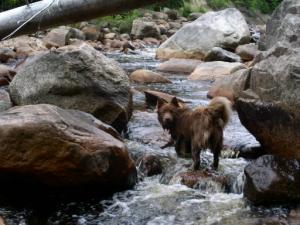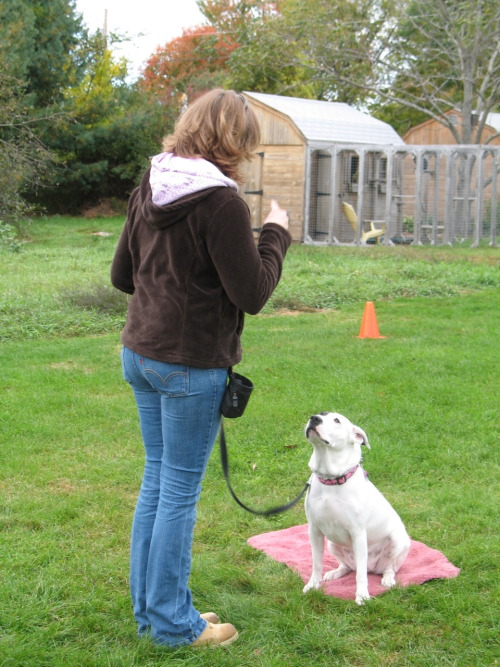ON SHODDY CLICKER TRAINING AND THE IMPORTANCE OF PREMACK

HOW NOT TO USE A CLICKER
"The other day my puppy was outside off leash. She took off chasing a deer. I called and called and she didn't come back. I clicked her a few times and she still didn't come back. She returned about an hour later, breathless. I put her in her crate when she came back to punish her for running off."
Every time I hear things like this, I get a few new grey hairs.
The first problem is, puppies should not be off leash unless they are in a securely fenced enclosure. A reliable recall, especially calling a dog off chasing a prey animal, is PhD level training. Most puppies are only at kindergarten level training. Even if they "normally" have a nice recall, chances are the behavior is not reliable enough to stand up to the holy grail of dog events, the deer chase. If dogs could receive titles in the sport of recall, I think the titles would include calling the dog mid-deer chase, thus earning the championship title TDC. Other notable levels of achievement in recall training include TSC (the squirrel chase) and RFP (recall from play).
Many people want to start their dog out with TDC, TSC, and RFP titles. Much like you can't write your dissertation before you know your ABC's, your puppy cannot be expected to recall off a prey chase if he hasn't received adequate training, and this type of training requires a substantial training commitment and investment.
That's all I'll say about recall training today. It's such an important topic it really is deserving of its own blog entry. Included in that entry will be a word of caution about ever punishing your dog for coming back to you, which will address the problematic last sentence in the quote above.
What I want to address in this particular post is this section: "She took off chasing a deer. I called and called and she didn't come back. I clicked her a few times and she still didn't come back."
Let's review the things that a clicker is and the things that a clicker does briefly.
A clicker is: a conditioned reinforcer. The most easily recognizable conditioned reinforcer for people is money, or a paycheck. Just as there is nothing inherently rewarding to people about possessing green pieces of papers covered in pictures of deceased presidents, there is nothing inherently rewarding to a dog about the sound of the clicker or the presentation of any other marker. The clicker has value because it is repeatedly paired with access to things the dog wants, most frequently food or play. Paychecks have vallue because they open the door of opportunity - through our paychecks, we can acquire the things we want or need. The click must always be followed by a reinforcer. Clicking without giving providing a reinforcer is like having your paycheck bounce. Would you go back to work the next day?
A clicker is: an event marker (also known as a "bridge"). I tell students to think of their clicker as a camera. You are using your clicker to "take a picture" of the behavior you like as the dog offers the behavior. The clicker functions in this capacity to tell the learner, "I like that behavior. Do it more often. Reinforcement is on the way!" (Can you see why a clicker is a more concise marker? It takes a long time to communicate all of those sentiments through spoken or written word!) When you are taking a picture, you can click the shutter button too early or too late and miss the shot. New photographers and clicker trainers are often too late and end up "taking a picture" of the wrong behavior. (You see this frequently in targeting. Students try to click when the dog's nose hits their hand. If the click is a fraction of a second too late, you click the dog turning away from your hand. Four or five clicks later, the dog won't even look at your hand, because she had been clicked for looking away. Click when the dog is in motion toward your hand!)
So what did the dog in the previous example get clicked for? Blowing off a recall and chasing a deer. We clicked her for running away after we cued the recall. What reinforcer followed the click? The opportunity to chase a deer, which more frequently than not trumps any kibble, hot dogs, or turkey you may be holding. (In my experience, no single treat will trump the allure of quickly moving prey. Liverwurst usually doesn't compete with something as exciting as a prey chase - a strong reinforcement history does.) Never underestimate the power of environmental reinforcers to work for (Premack) or against (blowing off cues) you in your training. When it works for you (Premack), you control access to environmental reinforcers. When it works against you, the dog controls access to environmental reinforcers and learns the owner is irrelevant in distracting environments.
So we called the dog, she ran away, and we clicked as she was running away. The behavior was reinforced heavily by what was likely one of the most exhilerating, exciting experiences of this young dog's life.
When you use the clicker as an "attention getter" or signal to your dog to focus on you, what you are actually doing is reinforcing the behavior of looking or running away from you. The clicker is a wonderful, precise communication tool but it is a double-edged sword - to be most effective, clicker trainers must really practice honing the mechanical skills of appropriate timing and reinforcement delivery. You must also be clear in what the clicker is (a conditioned reinforcer and an event marker) and what it is not (a recall cue or focus cue).
Instead of clicking your dog for looking or moving away from you, use it to capture any focus on you. Build a strong reinforcement history for focused attention.
Behavior is changed through the handler's ability to manipulate its consequences effectively. We must appropriately manipulate reinforcers, be they conditioned or unconditioned, primary or secondary, environmental or gastrointestinal, to work for us instead of against us.
BE THE BROCOLLI
Many dog handlers see deer, squirrels, other people or dogs, fast moving objects as hindrances, obstacles blocking the path to their dog's reliability. In fact, too frequently, the dog sees the owner as the obstacle, coming in between the dog and everything she wants in the world. I believe a paradigm change may greatly increase training success for dogs and their people. This paradigm shift is known as the Premack Principle. In dog training, Premack often means "thinking outside the treat bag."
The Premack Principle states that more probable behaviors (squirrel chase) will reinforce less probable behaviors (look away from squirrel and at mom). In laymen's terms, "if you eat your brocolli, you can have your ice cream."
Don't feel bad about being the brocolli. I'm the brocolli too. We're all the brocolli when it comes to competing with prey distractions.
We may be able to prevent our dog's access to these environmental reinforcers some or all of the time, but the fact is that we frequently can't modify our dog's instinctive attraction to prey objects, things that move fast or squeal, etc. What we can do is modify our training approach to take advantage of these doggy instincts. Change the focus from competing with these stimuli to putting them to work with you. "I see my dog wants this. How can I channel their attraction to this object into our training sessions?"
By becoming a squirrel chaser yourself. That's right, I said it. Be a little more "doggy" in your training style. If your dog is staring at a squirrel and then finally breaks her stare to give you eye contact, use a a clicker or other marker followed by an on-leash squirrel chase to reward the focus. Chasing the squirrel she was staring at is probably, in this context, more important to her than your hot dog bits. Following an event marker with something as exciting as a squirrel chase is something your dog will not soon forget.
This can be a revelation for some dogs. Instead of thinking, "I might be able to chase that squirrel if I could find a way to get past mom," your dog learns, "I might be able to chase that squirrel if I find a way to please mom!" A "mom" who will chase squirrels is infinitely more interesting to a dog than a "mom" who is a spoilsport and says "No squirrel chasing, no way, no how!" Vary your rewards so that your dog doesn't expect a squirrel chase every time he sees a squirrel...sometimes tug, sometimes great treats, sometimes a ball throw, sometimes do the "happy dance" with your dog, sometimes reward with an all-out sprint on the leash (running is a very potent reinforcer for my Chow!). If chasing the squirrel is a jackpot for your dog, save that platinum reinforcer and use it to reward her best efforts - the fastest eye contact, the quickest hand targets.
Clicker training is effective, but only if you use the clicker effectively. You get what you click. Only click behaviors you want, use effective reinforcement and management strategies, and put that deer to work for you instead of against you in your future training endeavors.
Happy training!



